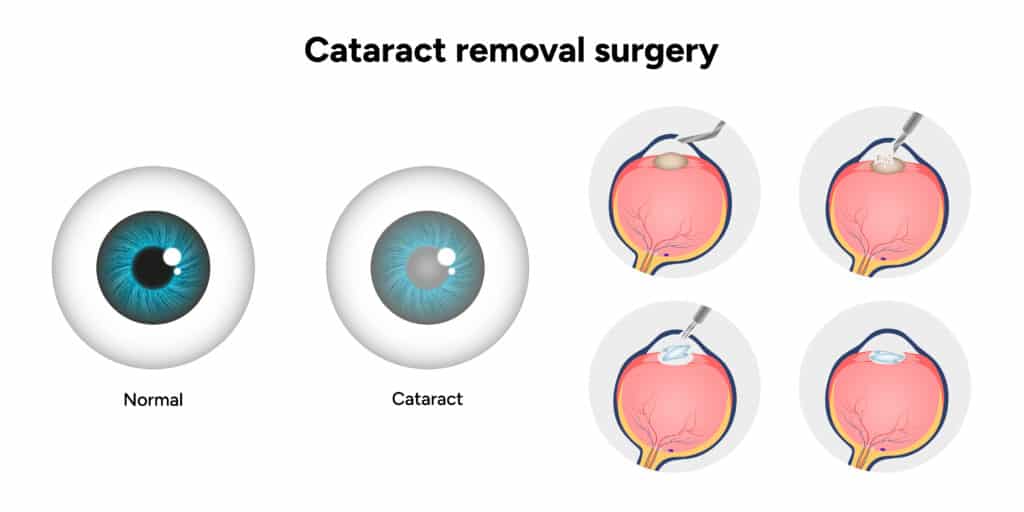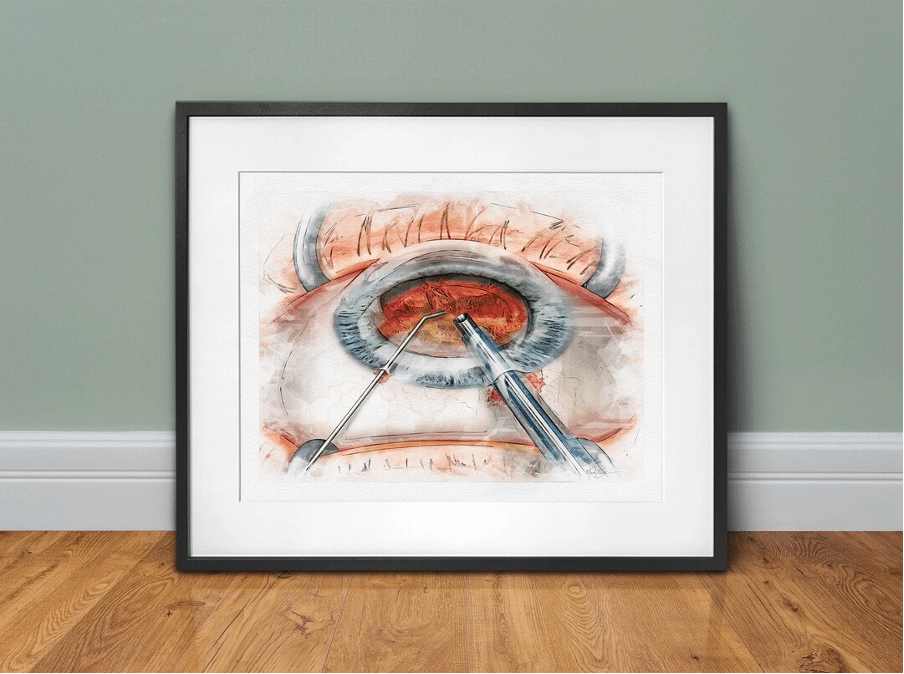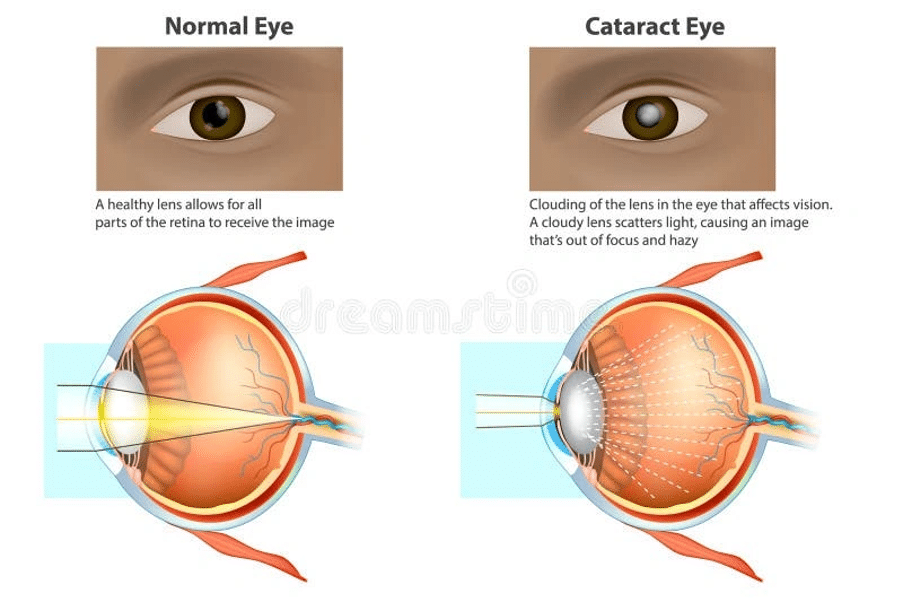Will cataract surgery give you 20/20 vision? This question is probably on your mind as you think over this life-changing procedure. Cataract surgery ranks as the most common surgical procedure in the UK, and with good reason too—it helps restore clarity when cataracts cloud your vision.
Yes, it is possible to achieve 20/20 vision after cataract surgery. Most patients can reach 20/20 visual acuity for distance vision, whatever type of intraocular lenses (IOLs) they use. The reality is a bit more complex though. Many people get perfect vision from their IOL, yet approximately 30 to 50 percent of people who choose a monofocal IOL need corrective lenses after surgery. You might wonder why perfect vision doesn’t come right after the procedure, since expectations tend to run high.
Let’s explore what shapes your visual outcomes, how different lens choices affect your results, and what might stand between you and perfect vision. Advanced diagnostic technology paired with expert surgical techniques will help you understand your real chances of seeing clearly after cataract surgery.

What does cataract surgery actually correct?
Let’s explore what cataract surgery does by first understanding how cataracts develop in your eyes.
How cataracts affect your vision
Your eye’s natural lens can develop cataracts when proteins break down and clump together. This creates cloudy areas that block light. Looking through a cataract feels similar to peering through a foggy window. The cataract’s growth makes your vision:
- Increasingly blurry or hazy
- More sensitive to glare with halos around lights
- Duller with a yellow tinge
- Harder to adjust in dim lighting
These changes happen because light can’t properly pass through your lens. Simple daily tasks like reading, night driving, or seeing faces become more challenging.

What cataract surgery removes and replaces
Our specialists at Precision Vision London perform a precise procedure to fix this vision problem. We remove the cloudy lens completely and put in a clear artificial lens, known as an intraocular lens (IOL).
Phacoemulsification stands out as the most common technique. The surgeon makes a tiny corneal incision and uses an ultrasonic probe. This probe breaks the cloudy lens into small pieces that we gently suction out. The new artificial lens fits perfectly in the same capsule where your natural lens used to be.
IOLs use clear materials that let light pass through easily. These lenses come with different focusing powers to fix nearsightedness and farsightedness. Some IOLs can even correct astigmatism.
Does cataract surgery improve vision overall?
The results speak for themselves – most patients see dramatic improvements. This procedure has become a soaring win, with approximately 97% of people getting better vision afterward. A successful recovery typically brings:
- Crystal-clear vision
- Less sensitivity to glare
- Better colour perception
- Reduced dependence on glasses
Adults with cataracts have only one proven treatment option – surgery. At Precision Vision London, advanced diagnostic tools help us pick the perfect IOL to match your visual needs. This maximises your chances of getting the best results. Medications and lifestyle changes don’t work for cataracts. Surgery remains the only real solution when your vision starts affecting your daily life.
Can cataract surgery give you 20/20 vision?
Our patients often ask about their vision after cataract surgery. Let me explain what you can expect to see once your eyes have healed.
What 20/20 vision really means
“20/20 vision” measures how sharp your eyesight is at a distance of 20 feet compared to someone with normal vision. Countries using the metric system call this 6/6 vision, measured at 6 metres instead of 20 feet. Your vision involves more than just the 20/20 measurement. This number shows your distance vision’s clarity, but your overall visual function depends on other factors like peripheral awareness, depth perception, and colour vision. Only 35% of adults naturally see 20/20 without any correction.

How often patients achieve 20/20 after surgery
Cataract surgery boasts a soaring win rate of over 98%, and patient satisfaction runs high. More than 90% of patients end up with 20/40 vision or better – clear enough to handle most daily tasks. Here at Precision Vision London, our patients achieve 20/20 distance vision with most types of intraocular lenses (IOLs). Yet 30-50% of people who get a monofocal IOL still need glasses afterward.
Your chances of achieving 20/20 vision depend on:
- How precisely we calculate your refractive error beforehand
- The IOL’s position during surgery
- Any existing eye conditions like diabetic retinopathy or glaucoma
- Your age and possible surgical complications
Can you get better than 20/20 vision?
The answer is yes! Some patients see even better than 20/20 after surgery. To name just one example, see 20/15 vision – you’ll see clearly at 20 feet what others need to be 15 feet away to see. Our team at Precision Vision London takes a personalised approach. We choose premium IOLs that can deliver exceptional results, especially when your eyes have no other conditions.
How lens choice affects your visual outcome
Your choice of intraocular lens (IOL) will shape how well you see after cataract surgery. The lens you pick affects your chances of getting 20/20 vision and whether you’ll need glasses later.
Monofocal lenses and their limitations
Monofocal lenses are the most common IOL choice with a single focusing power. These lenses give you crystal-clear vision but only at one distance—usually set for seeing things far away. Most patients who get monofocal IOLs still need reading glasses for close work. These lenses have proven their worth over decades of use. They’re also available through insurance and Medicare, which makes them a practical choice for most patients.

Multifocal and accommodating lenses
Multifocal lenses work differently. They have several focal zones that let you see clearly at all distances—close up, middle range, and far away. These premium IOLs will substantially cut down your need for glasses. Studies show that 95% of patients don’t need eyewear for their daily tasks after getting these lenses.
Accommodating lenses take a different approach. They move inside your eye to work like your natural lens did. You’ll get better distance vision with these than multifocal options, and they help with near vision too. Both types might cause temporary effects like seeing halos around lights at night.
Toric lenses for astigmatism
Toric IOLs are perfect if you have astigmatism. These special lenses correct your cornea’s irregular shape with different powers in different directions. Research shows that 94% of patients with toric lenses can see 20/40 or better without glasses. You can get toric correction in any lens type—monofocal, multifocal, or accommodating. This makes them a great fit for many vision needs.
How we personalise IOL selection at Precision Vision London
Precision Vision London uses cutting-edge biometric measurements and corneal topography to map your eye’s structure. This detailed approach helps us match the right IOL to your lifestyle and vision goals. We’ll work with you to help you understand all your options before you decide. Want to see life clearly again? Book your consultation with Precision Vision London today and learn if you can achieve 20/20 vision after cataract surgery.
What can prevent 20/20 vision after surgery?

Cataract surgery has impressive success rates, but several factors can stop patients from achieving 20/20 vision afterward. Setting realistic expectations requires understanding these potential roadblocks.
Pre-existing eye conditions
Your vision after cataract surgery depends heavily on your overall eye health. These existing conditions can limit your chances of getting perfect vision:
- Age-related macular degeneration
- Diabetic retinopathy
- Retinal vein occlusion
- Corneal opacity or pathology
- Glaucoma and other optic neuropathies
These conditions rank among the biggest risk factors linked to suboptimal visual outcomes. The surgery can’t fix these underlying problems because they affect different parts of the eye than the lens itself.
Incorrect IOL power or placement
The success of the procedure depends on exact pre-surgical measurements. Here’s what matters most:
IOL power errors happen most often due to wrong corneal power calculations, followed by mistakes in axial length measurements. Sometimes human error leads to putting in the wrong IOL completely.
The IOL might move slightly during surgery even with perfect measurements. This changes its position and affects how well you see. These “refractive surprises” happen in about 5-10% of lens implantations.
Postoperative complications like macular oedema
Cystoid macular oedema (CME) tops the list of complications after cataract surgery. It affects about 1-2% of cases. This happens when fluid builds up in the macula and reduces vision.
Other possible complications include:
- Posterior capsular opacification (PCO) – shows up in 14-60% of surgeries
- Retained lens fragments
- Chronic corneal oedema
The good news is that doctors can successfully treat most of these complications with proper care.
How we minimise risks with advanced diagnostics
Precision Vision London’s team uses several approaches to maximise your chances of achieving 20/20 vision:
Our full pre-surgical assessment has advanced imaging like optical coherence tomography (OCT) to spot risk factors before surgery. Multiple measurements help us calculate IOL power accurately.
Strict safety protocols protect our patients. We use surgical “time-out” procedures to verify the correct patient, procedure, eye, and IOL implant. Patients with pre-existing conditions might need extra treatments before surgery to get the best results. Our careful planning and precision help remove obstacles between you and perfect vision.
Conclusion
Cataract surgery stands out as one of the most successful medical procedures today. Most patients see their vision improve by a lot. Your chances of getting clear, sharp vision remain high, though achieving 20/20 vision depends on factors like your eye health and the type of intraocular lens chosen. Our expert surgeons at Precision Vision London use state-of-the-art diagnostic technology to get a full picture of your eyes before surgery. This ensures the most precise IOL calculations possible.
Your lens choice is a vital part of your visual outcome. Monofocal lenses deliver excellent clarity at one distance. Premium options like multifocal, accommodating, and toric lenses are great ways to get more benefits if you want less dependence on glasses. Our specialists spend time understanding your lifestyle needs and visual goals to recommend the best option for you.
Pre-existing conditions or possible complications might seem concerning. These risks decrease with our detailed pre-surgical assessment and precise surgical techniques. Most patients can expect excellent results, and many achieve 20/20 vision or better after their procedure.
Would you like to see life clearly again? Book a consultation with Precision Vision London today to learn if 20/20 vision is possible after your cataract surgery. Your path to restored vision starts with understanding your unique eyes and expectations – something we take pride in at Precision Vision London. Cataract surgery goes beyond removing a cloudy lens. It gives you the gift of clear vision tailored to your specific needs.
FAQs
Q1. What are the chances of achieving 20/20 vision after cataract surgery? Most patients can achieve 20/20 visual acuity for distance vision after cataract surgery. However, the exact outcome depends on factors like pre-existing eye conditions, lens choice, and surgical precision. Over 90% of patients achieve 20/40 vision or better, which is sufficient for most daily activities.
Q2. Will I still need glasses after cataract surgery? It depends on the type of intraocular lens (IOL) implanted. With monofocal IOLs, about 30-50% of people still require glasses for certain activities, particularly for near vision. Premium multifocal IOLs can significantly reduce dependence on glasses, but may not eliminate the need entirely.
Q3. How long does it take to see clearly after cataract surgery? Many patients notice improved vision immediately after surgery. However, it can take a few days to a few weeks for your vision to stabilise completely. Follow your surgeon’s post-operative instructions carefully for the best results.
Q4. Can cataract surgery correct other vision problems? Cataract surgery primarily addresses the clouding of the natural lens. However, it can also correct refractive errors like nearsightedness, farsightedness, and astigmatism to some extent, depending on the IOL chosen. Pre-existing conditions like macular degeneration or glaucoma may still affect vision after surgery.
Q5. What factors might prevent achieving 20/20 vision after cataract surgery? Several factors can impact visual outcomes, including pre-existing eye conditions, incorrect IOL power calculations, complications during surgery, and postoperative issues like macular oedema. Advanced diagnostic technology and experienced surgeons can help minimise these risks and optimise results.
Authors & Reviewer
-
 Olivia: Author
Olivia: AuthorHi, I'm Olivia, a passionate writer specialising in eye care, vision health, and the latest advancements in optometry. I strive to craft informative and engaging articles that help readers make informed decisions about their eye health. With a keen eye for detail and a commitment to delivering accurate, research-backed content, I aim to educate and inspire through every piece I write.
-
 Dr. CT Pillai: Reviewer
Dr. CT Pillai: ReviewerDr. CT Pillai is a globally recognised ophthalmologist with over 30 years of experience, specialising in refractive surgery and general ophthalmology. Renowned for performing over 50,000 successful laser procedures.


